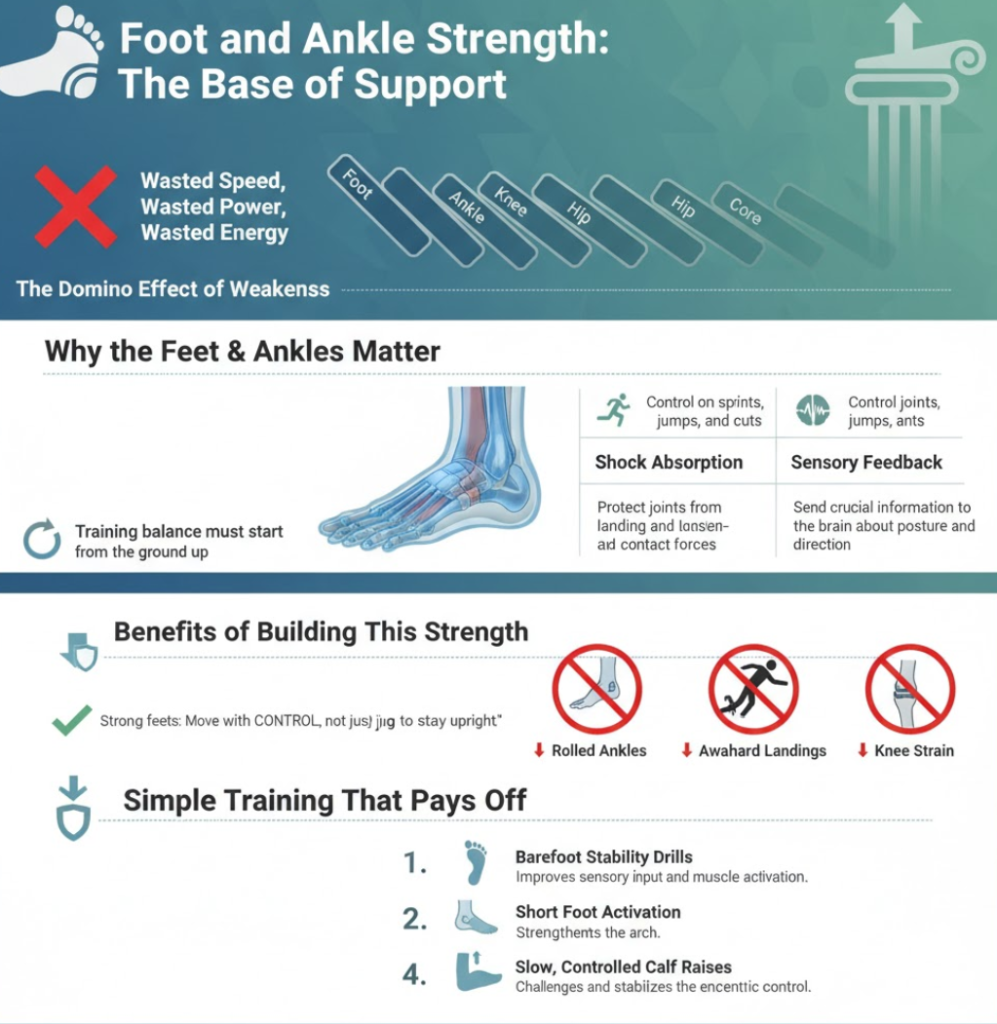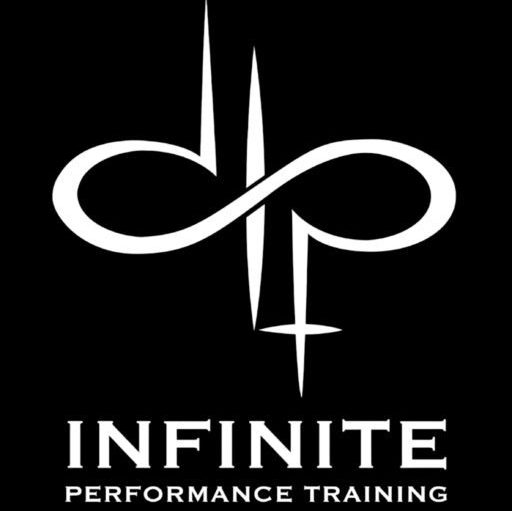Are you looking for balance training techniques and tips?
Here at Infinite Performance Training of Gainesville, VA we offer balance training for athletes that helps them with their overall athletic performance!
Games are often won in the half-second moments. A plant step. A landing. A turn. Balance training sharpens those micro-movements so you control the play instead of reacting to it. If you want the advantage that doesn’t run out late in the game, keep reading.
The Foundation of Balance: How the Body Maintains Control
Balance is not luck, that is what we tell all of our athletes. It is a coordinated system of muscles, joints, reflexes, and sensory feedback working together in real time. When an athlete cuts, jumps, lands, pivots, or absorbs contact, the body makes thousands of micro-adjustments to stay upright and efficient.
The stronger and more trained these systems are, the more effortless the movement feels. When they are weak or untrained, athletes look rushed, unstable, or “sloppy,” even if they have strength and speed. True balance is learned, trained, and refined the same way any athletic skill is.
The Role of Core Musculature
The core is more than abs. It includes the deep stabilizers around the spine, obliques, pelvic muscles, and the muscles controlling the hips and ribs. These muscles do not just produce force; they control force. A strong core holds posture during movement, keeps the torso stable while the legs drive power, and keeps the body from collapsing under pressure or fatigue.
When the core is weak:
- Movements look loose or inefficient
- Power leaks out through the midsection
- Knees and ankles take stress they were never designed for
When the core is trained well:
- Movement feels smooth, controlled, and explosive
- Athletes react faster and change direction without hesitation
- Posture stays strong deep into the game
Strength can be developed in the weight room, but control is built through slow, resisting movements like carries, planks, and anti-rotation drills.
Proprioception and Body Awareness
Proprioception is your body’s ability to sense its position in space. It’s how athletes know where their limbs are, even when they are not looking. This sense is built through repetition, controlled movement, and challenge. Good proprioception is why elite athletes look composed in chaos. Bad proprioception is why others look like their feet can’t keep up with their brain.
When proprioception is strong:
- Foot placements are precise
- Movement changes happen quickly
- Balance adjustments are automatic, not forced
When it’s weak:
- The body hesitates
- The athlete overcorrects
- Movements look stiff or panicked
Foot and Ankle Strength as the Base of Support

The feet and ankles are the foundation of every athletic movement. If the foot collapses or the ankle wobbles, the knee, hip, and core all have to compensate. That compensation wastes speed, power, and energy. Training balance must start from the ground up.
Why the feet matter:
- They control force transfer on sprints, jumps, and cuts
- They absorb shock from landing and contact
- They send feedback to the brain about posture and direction
Small muscles in the feet and ankles decide whether an athlete moves with control or just “tries to stay upright.” Building this strength reduces rolled ankles, awkward landings, and knee strain.
Simple training that pays off:
- Barefoot stability drills
- Short foot activation
- Single-leg balance holds
- Slow, controlled calf raises
Core Strength for Real Athletic Movement
Can you stay strong when play intensity spikes? Core strength is the anchor for speed, direction change, and power transfer. Without it, movement leaks energy instead of delivering it.
Anti-Rotation Training
Most sports movements occur as the body struggles to stay aligned. Anti-rotation work teaches the core to stay steady when force tries to twist it. This builds usable strength that shows up in cuts, jumps, and contact.
| Exercise | How to Do It | Focus |
|---|---|---|
| Paloff Press | Stand, band or cable at chest height, press straight out | Resist twisting through the trunk |
| Dead Bug | Opposite arm and leg reach while spine stays still | Teaches control while limbs move |
| Suitcase Carry | Walk holding one dumbbell at your side | Builds side-to-side stability |
Hip Stability and Glute Activation
Hip stability is what makes some average athletes great. Every sport starts with a stance, and so focusing on your hip and glute activation is vital for your balance training!
Strong glutes and hips keep the knees tracking cleanly and stably. When this chain stays aligned, athletes move faster, land safely, and avoid wasted movement.
| Exercise | How to Do It | Focus |
|---|---|---|
| Glute Bridge | Raise hips, squeeze glutes at top | Activates glutes over lower back |
| Clam Shell | Open knee outward with band resistance | Strengthens hip abductors |
| Lateral Band Walk | Step sideways under control | Builds hip stability for cuts and defense footwork |
Midline Control Under Fatigue
When fatigue hits, athletes with trained midline control keep posture, speed, and coordination while others break down. This is the difference between finishing strong and fading.
| Exercise | How to Do It | Focus |
|---|---|---|
| Plank Variations | Hold spine neutral while breathing slow | Hold posture under time pressure |
| Tempo-Loaded Squats | Slow down the lowering phase | Teaches control under load, not just strength |
| Carry + Sprint Circuits | Carry weight, then sprint | Tests form when tired |
Landing Mechanics for Injury Prevention
Good landing form protects the knees, hips, and lower back. Soft knees and hips back help absorb force. Quiet feet mean control, not collapse. The goal is to land with balance already in place, not search for it afterward.
| Exercise | How to Do It | Focus |
|---|---|---|
| Box Drop to Stick | Step off a low box, land softly, freeze | Teaches body to absorb force safely |
| Jump + Hold | Jump vertically, land, hold for 2 seconds | Reinforces knee and hip alignment |
| Single-Leg Landing | Hop forward, land and balance on one foot | Challenges balance and ankle control |
Deceleration Training

Every athlete talks about speed. Few train the skill that allows speed to stop safely. Deceleration protects joints and turns momentum into control. When athletes learn to brake well, change of direction becomes faster and safer.
| Exercise | How to Do It | Focus |
|---|---|---|
| Eccentric Squat (Slow Lower) | Lower for 4–6 seconds, stand normally | Builds control under load |
| Short Stop Step Runs | Sprint 10–20 yards, stop in 3 steps | Teaches organized braking |
| Lunge + Pause Control | Step into lunge, freeze, push back | Trains balance during movement |
Contact Balance for Collision Sports
In sports with contact, holding posture under pressure wins space, position, and time. The goal isn’t to be rigid. It’s to be stable. A stable athlete absorbs force without losing alignment.
| Exercise | How to Do It | Focus |
|---|---|---|
| Partner Lean + Resist | Stand shoulder-to-shoulder, lean in, hold | Trains stable torso under force |
| Low Pad Shuffles | Shuffle while holding a pad at chest | Builds lower-body drive and balance |
| Controlled Bump + Stick | Light chest bump, athlete stays balanced | Teaches posture recovery after contact |
GET IN TOUCH
Schedule a Training Session
Sample 20–30 Minute Balance Training Session
This session builds balance that shows up in game play, not just warm-ups. It trains control, stability, landing mechanics, and quick footwork in sequence.
| Block | Time | Exercises | Purpose |
|---|---|---|---|
| Activation / Warm-Up | 4 minutes | Lateral band walk, glute bridge, short-foot activation | Switch on stabilizers before movement |
| Core Stability Block | 6 minutes | Paloff press holds, suitcase carry, plank with controlled breathing | Build trunk control and prevent energy leaks |
| Single-Leg Strength + Balance | 8 minutes | Single-leg RDL, step-downs, split squat holds | Train balance while producing force |
| Reactive Footwork + Movement | 8 minutes | Partner call-out cuts, shuffle-stick drills, forward-backward reaction steps | Build control during fast changes of direction |
| Landing and Deceleration | 4 minutes | Jump and stick, drop and absorb, decel from short sprint | Train safe landing and braking mechanics |
Common Mistakes Athletes Make With Balance Training
1. Trying to Train Balance on Unstable Surfaces Too Soon
Balance isn’t built on foam pads or wobble boards at the start. Those tools often mask weak foot engagement and poor ankle alignment. Real improvement begins on the ground, barefoot or in stable shoes, teaching the feet to grip and support the body.
What to do instead:
- Single-leg holds on flat ground
- Controlled step-downs
- Light barefoot foot-strength drills
2. Moving Too Fast and Skipping the “Control” Phase
If movement is shaky, rushed, or compensating, the athlete is simply reinforcing instability. Balance requires slow reps early on so the nervous system learns proper muscle sequencing.
Good balance looks quiet, controlled, and smooth—not frantic.
Focus cues:
- Slow down on the lowering phase
- Pause on each landing
- Breathe while holding posture
3. Ignoring Foot and Ankle Strength
Most balance issues start at the ground level. Weak arches and weak ankle stabilizers force the knees and hips to compensate. This leads to sloppy cuts, loud landings, and increased joint stress.
Signs of weak foot/ankle support:
- Toes grip the floor for balance
- Ankles collapse inward
- Knees buckle during movement
4. Training Balance Only When Fresh
Anyone can balance when rested. The real test—and the real benefit—shows up when fatigue hits. Late in practice or competition, form breaks down and injuries occur.
Balance should be trained:
- After conditioning circuits
- At the end of strength sets
- During sports movement under light fatigue
5. Treating Balance as a “Side Extra” Instead of a Core Skill
Some athletes see balance as an add-on to a warm-up. But balance is woven into every movement pattern: sprinting, cutting, landing, striking, jumping, absorbing contact.
When balance improves:
- Speed becomes easier to control
- Cuts become sharper and safer
- Joints stop overworking
- Power transfers cleanly through the whole body
The Final Word on Balance Training
We know that Infinite Performance Training, the entire athlete matters! This means balance is just as important as explosive training and recovery.
You already work hard. Now it’s time to work smart.
Remember, balance training is the difference between almost making the play and owning the moment. If you want that edge, we’ll help you build it. Message us below, and let’s raise your floor and your ceiling with our elite training programs!


 Turner | Baseball Athlete
Turner | Baseball Athlete
Leave a Reply